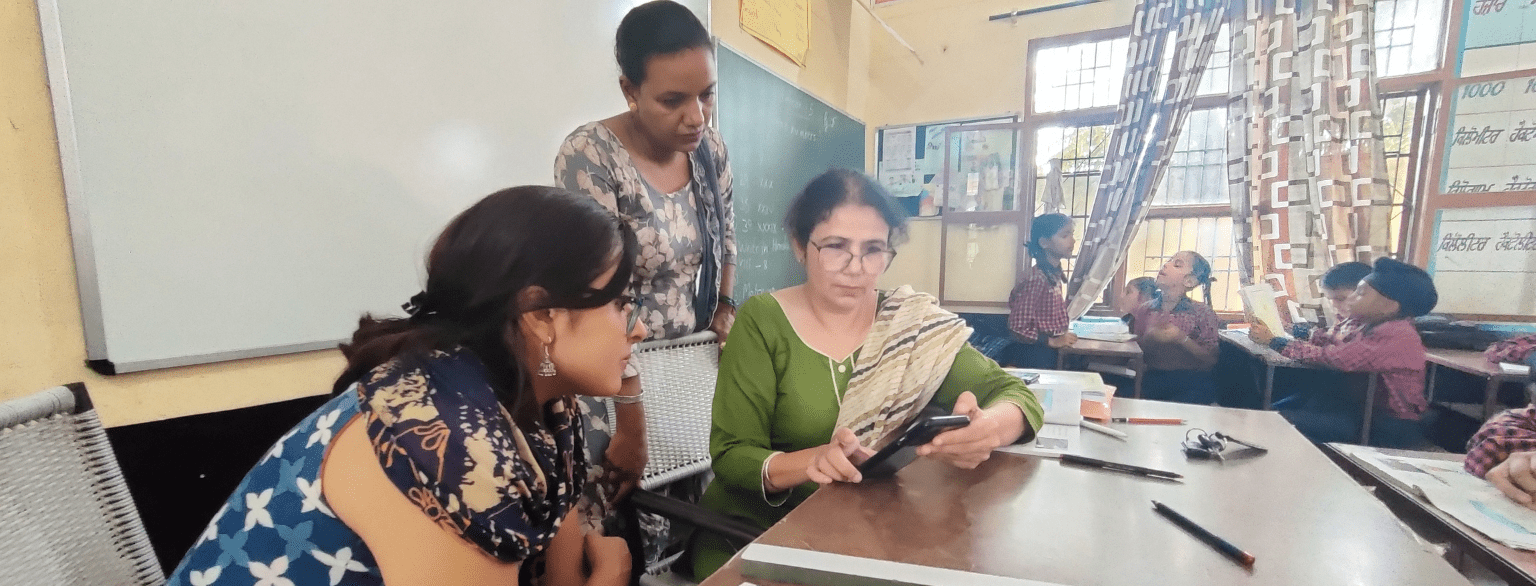
ShikshaLokam’s Prototyping Recipe
Imagine a bright, sunny Sunday morning. You have invited your friends over for brunch. As you consider what to cook, you spot those juicy, red tomatoes on the counter, and you’re instantly taken back to your mom’s famous red sauce pasta. After an hour in the kitchen, the pasta is made, and the sauce is slowly coming to a boil. You add a pinch of salt, pepper for the heat, and some garnish to complement the tanginess of the tomatoes flawlessly.

Before you serve it, you want to make sure that everything is perfect. You take a spoonful of the sauce to taste and offer some to your roommate too. This little test helps you to refine the pasta with the same heavenly feeling that you got when your mom made it for you.
You are now sure that it is nothing less than perfection. All you have to do now is sit back and let the compliments pour in!
What Is A Prototype?
Just like how tasting is an integral process of cooking, prototyping is an integral part of design. Through a prototype, a design can be brought to life and shared with users who can give real-time feedback on its effectiveness which then allows the designer to refine the design and set it up for success before finalizing.
A prototype is a simple experimental model of a proposed solution used to test or validate ideas, design assumptions and other aspects of its conceptualization quickly so that the designer/s involved can make appropriate refinements or possible changes in direction. (Source: Interaction Design Foundation)
Why Do We Need To Prototype?
Prototyping is an essential step in designing and developing that allows for necessary course correction before the final launch. A prototype can be tested out to gauge the relevance of the product for users, and necessary changes can be made before the final product is released. This small yet crucial step can save a lot of resources that would otherwise be spent on redesigning the product.
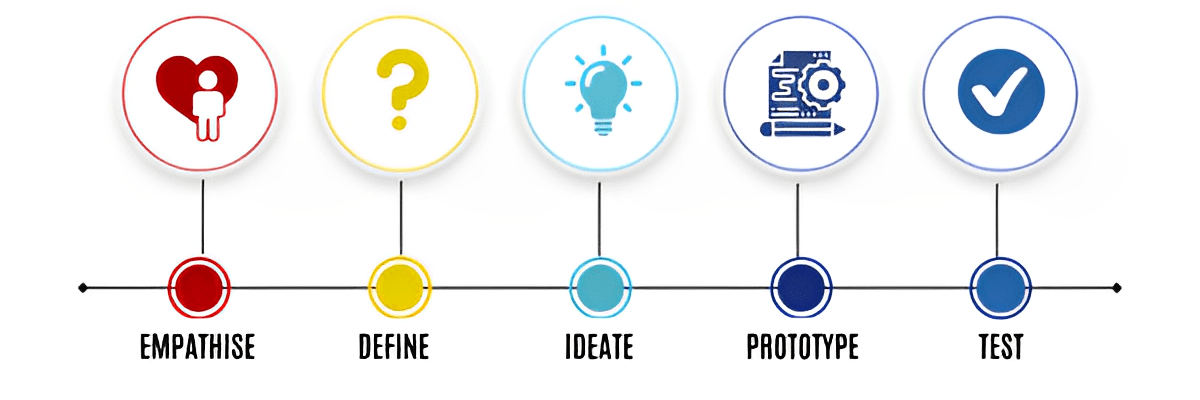
Design Thinking Process
At ShikshaLokam, we design for scale, for a diverse set of stakeholders across the education leadership landscape. In this piece, we explore a product prototype that was undertaken to test its effect on increasing user motivation to engage on a tech platform. ShikshaLokam’s users are education leaders who often take up micro-improvement projects in their schools to improve student outcomes. They use the DIKSHA platform as a tool to take up these micro-improvement projects and to document and share them. The prototype aimed to test features that would motivate users to complete micro-improvement projects that they have taken up and also to take on more such projects.

To conduct an effective brainstorming space that would yield a strategy to increase motivation in users, the ShikshaLokam team participated in Innovation Revolution (IR) – an initiative to encourage innovation and problem solving within the team. The team worked in smaller, cross-functional teams, and presented their ideas to an external jury that selected the best solution. The idea of the winning team was taken to the field for prototyping.
Solutions That Were Prototyped:
1. To create a sense of excitement and reward users for every step of their project, we created a solution where users could earn points for each action they took on the app.

Points Rubric for users to earn points on the app while they take up the project.

A leaderboard to show users (school leaders) their rank based on the number of points earned.
2. Users often shared photos and videos of their school activities with their peers as a way to share their highlights and best practices. To give users a way to share their journey of taking up improvement projects, a solution was developed where a video montage was created from the different photos shared by users along with the steps they took to complete their projects.
The video was created for the top-scorers and shared with them. Thus, it incentivized the users further to take action on the app and earn more points so that they would receive the video. It was also a way for the community of school leaders to get an insight into the best practices in other schools.
Implementation Of The Prototype:

Stages of Implementation
Here Is How We Did It:
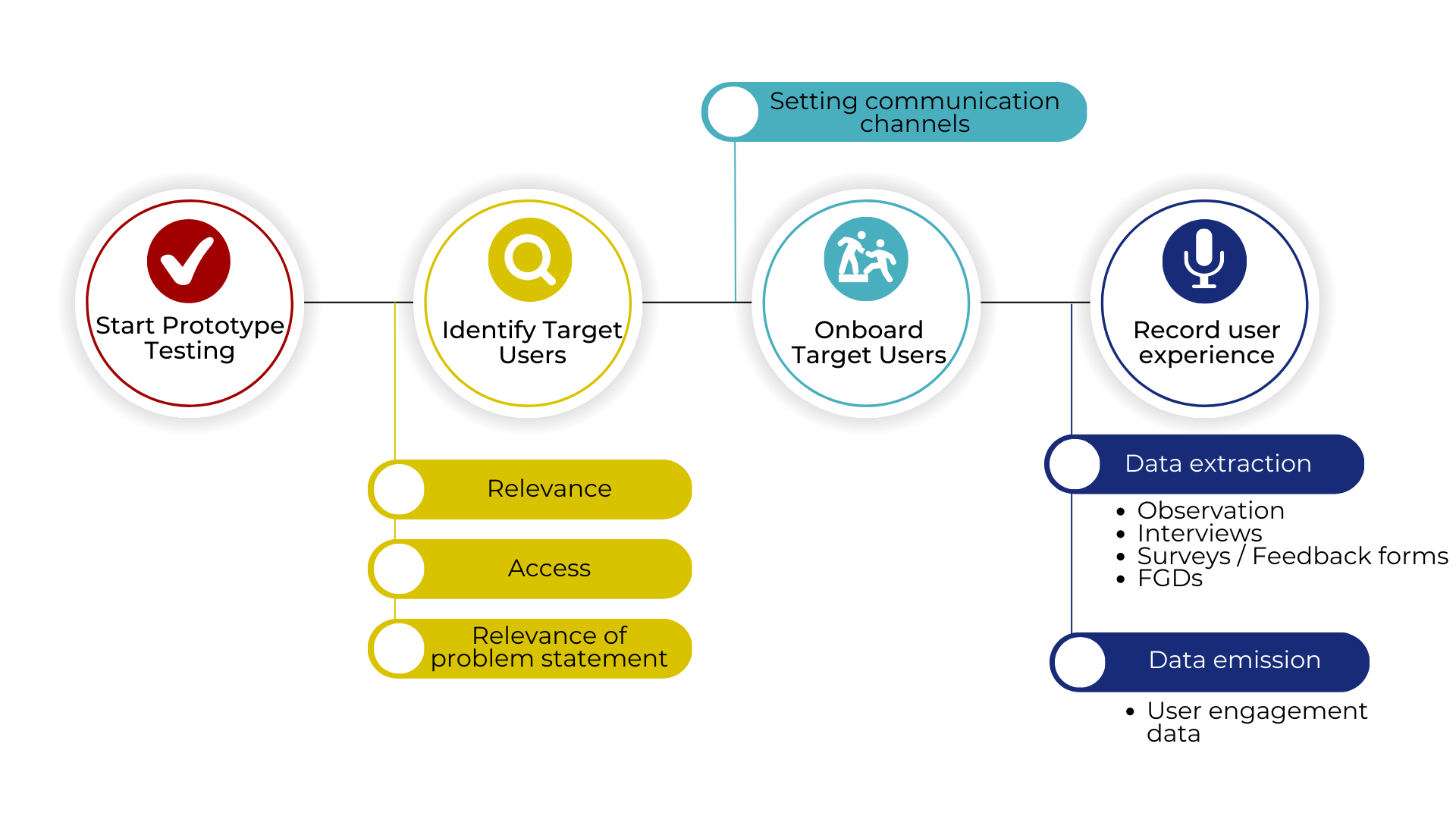
Process of Prototyping
1. Identifying And Onboarding Target Users
We selected a block in the State of Punjab as our prototyping ground where users were already taking on micro-improvement project on Parent Teacher Meeting. We leveraged an existing relationship with State officials there who helped in identifying school leaders who would be willing to try a new idea, have access to the DIKSHA app and also to obtain the necessary permissions.
WhatsApp groups were set up as a communication channel as it was easy to use and accessible to all our target users. Orientation sessions were held online to reach all school leaders at once to introduce them to the prototype and to set context and expectations.
As our solution aimed to increase engagement on the app, school leaders were oriented on how their actions on the DIKSHA app could lead to recognition and reward through the leaderboard and social recognition videos.
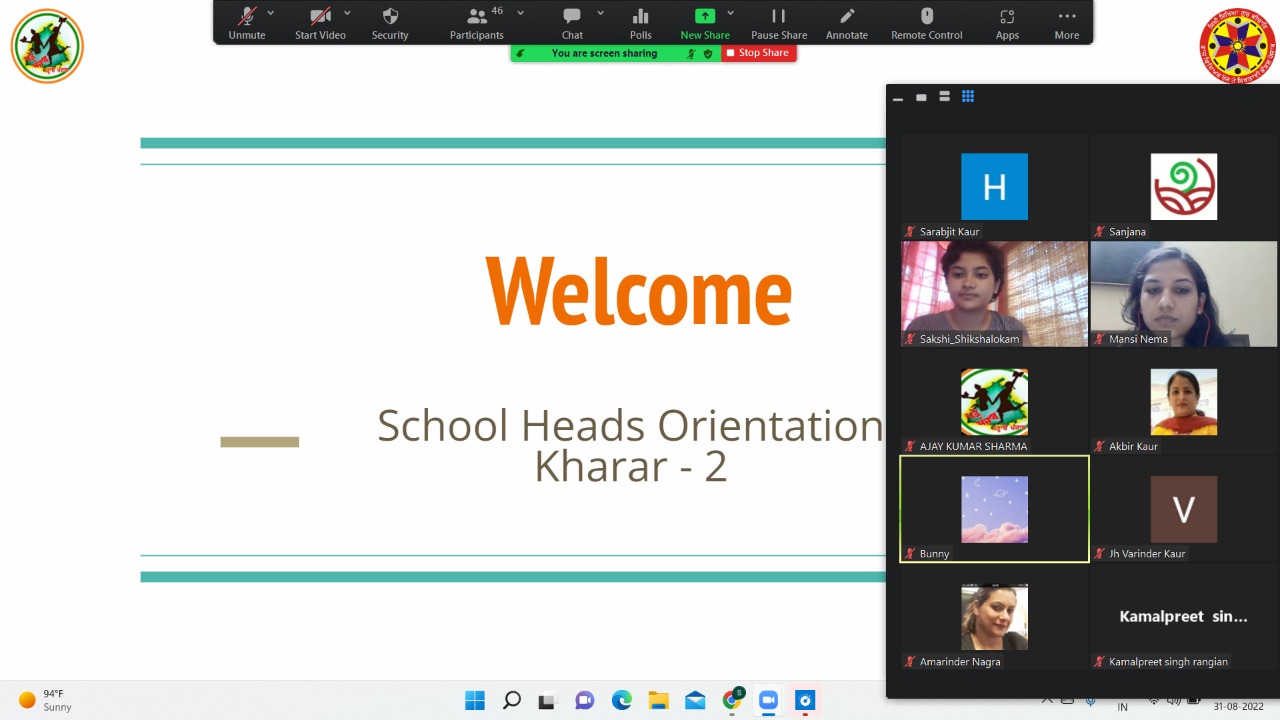
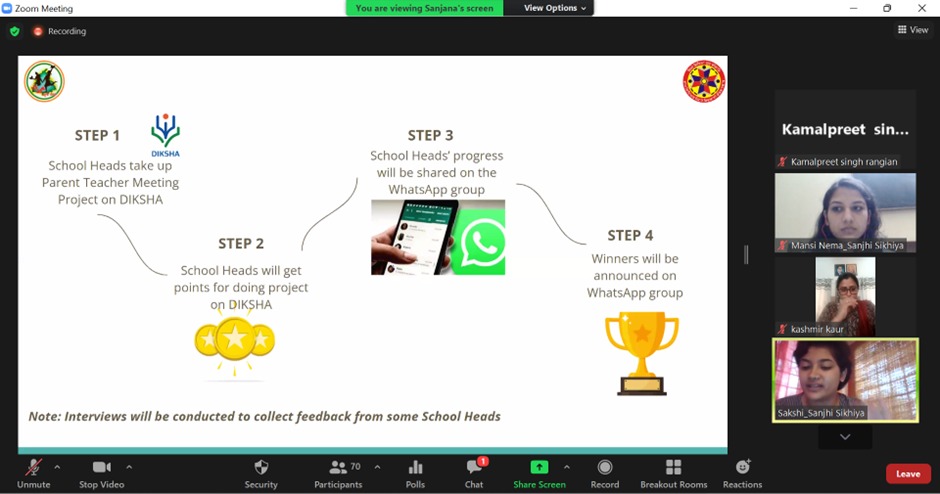
2. Recording User Experience
After introducing the recognition and reward structures to the school leaders, their behavior on the app was closely monitored. This was done by analyzing engagement data generated on the app and by observing users’ communication and sharing patterns on the WhatsApp group.
At the end of the testing, feedback forms were rolled out where users could share their experiences on different aspects of the solution. Interviews were also conducted with a few users to get in-depth feedback on the solution.

School head engaging with the platform in their school
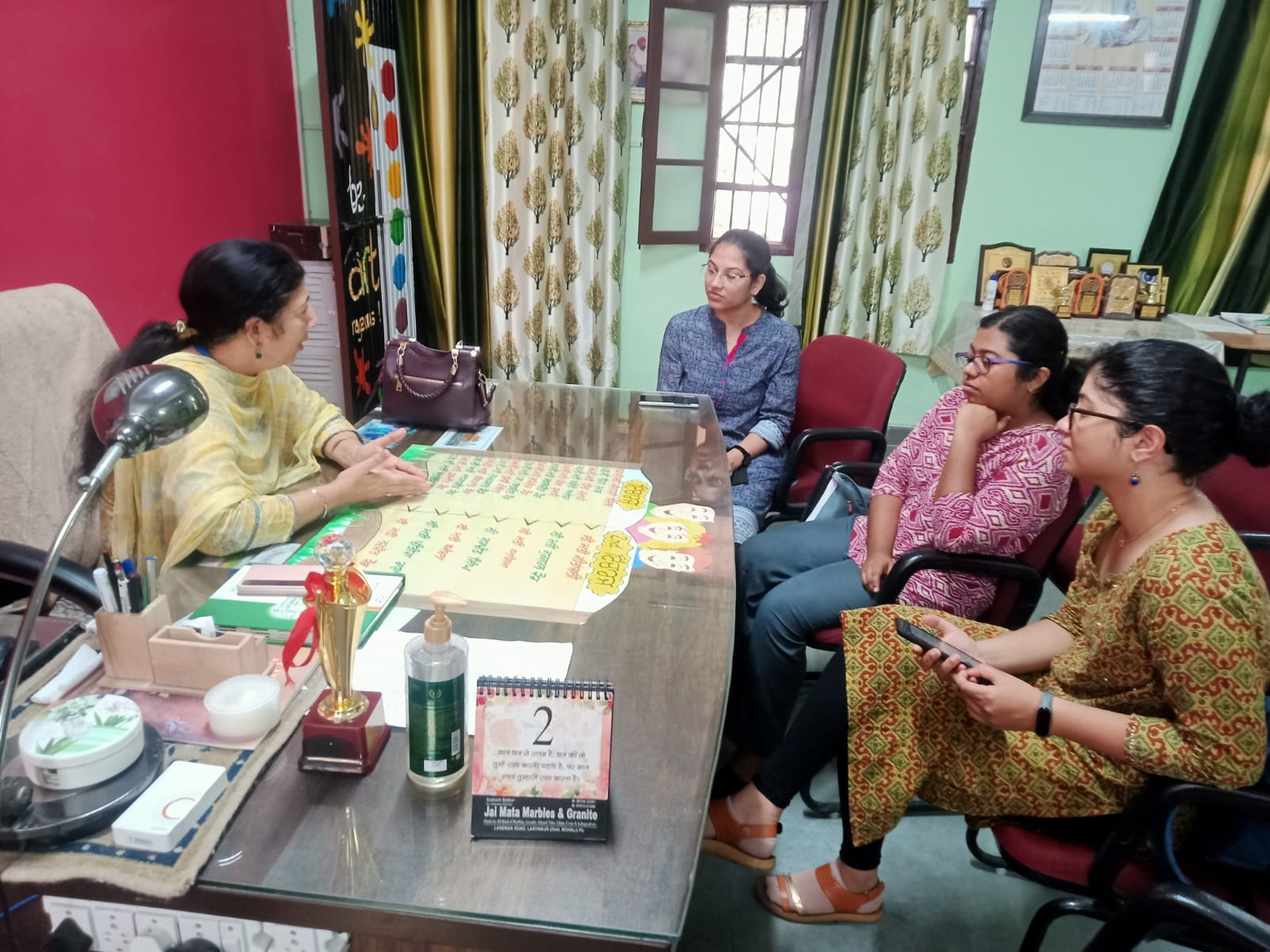
Collection of user feedback through field visits and interviews
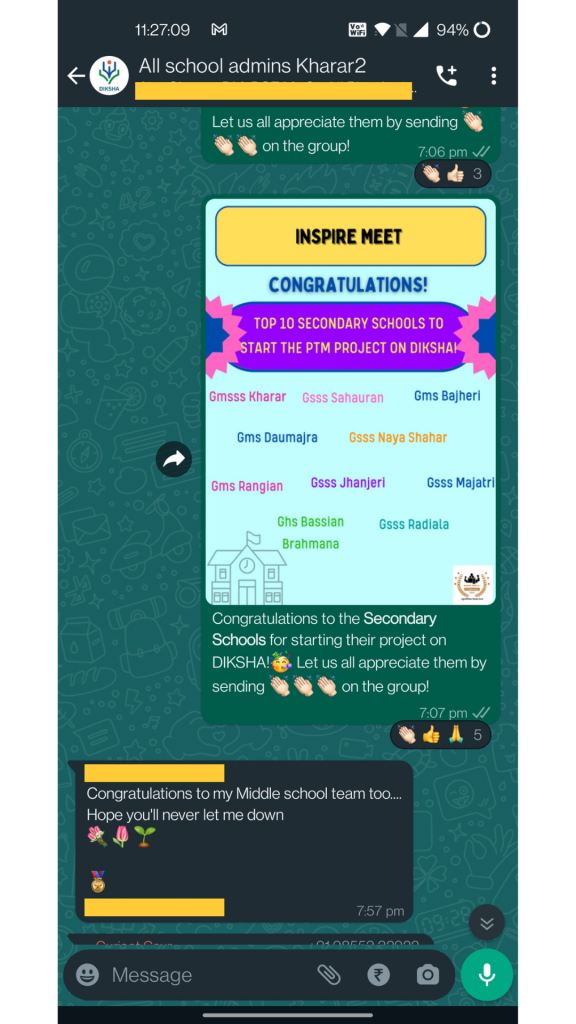
Reactions shared on the WhatsApp group
User Testimonial:
HM of a Government Middle School, shared that when her school’s name appeared on the WhatsApp poster that recognised the first ten schools to have started the project, she felt extremely happy and thought to herself-
“Now that my school’s name has come, I have to make sure we give our best efforts towards the project”
– Headmaster
Outcome
The ranking/ leaderboard and the social recognition prototype received a positive reaction from the users. The submission rate of Punjab for the other groups that were not part of the prototype was 14%, but our controlled group had a submission rate of 63%.
There was a significant increase in people’s motivation to take action on the ground as these prototype ideas evoked feelings of –
Her school ultimately was ranked on the final leaderboard as one of the top 5 scorers.
Sense of community
Sense of pride
Learning from others
A good rank to them was an achievement that would be celebrated along with everyone they worked with – students, staff, parents, and community members. As most school heads extensively collaborate with their school staff for all the work they take up, a ‘rank’ was a great way for them to credit those who are putting their effort into bringing outcomes to their school.
Many school heads also shared that the school achieving a rank would bring a good reputation to the school in the eyes of the community and would make a solid case to encourage parents to enroll their children in the government school.
A common response to a rank system was that users wanted to learn the best practices from the top-ranked schools to have a learning experience and take those learnings back to their own school teams. This indicates that this solution would be helpful not only for the top scorers but to all of the users.
Sense of community
A good rank to them was an achievement that would be celebrated along with everyone they worked with – students, staff, parents, and community members. As most school heads extensively collaborate with their school staff for all the work they take up, a ‘rank’ was a great way for them to credit those who are putting their effort into bringing outcomes to their school.
Sense of pride
Many school heads also shared that the school achieving a rank would bring a good reputation to the school in the eyes of the community and would make a solid case to encourage parents to enroll their children in the government school.
Learning from others
A common response to a rank system was that users wanted to learn the best practices from the top-ranked schools to have a learning experience and take those learnings back to their own school teams. This indicates that this solution would be helpful not only for the top scorers but to all of the users.


Way Forward
Meet the Authors

Sanjana DM
Sanjana has always been a firm believer in the power of effective design to drive meaningful change. Her interest in travel, music, art & culture inspires her to think beyond the conventional. A former Teach for India fellow, she currently works with ShikshaLokam to design product solutions for education leaders across the country.

Sanjana DM
Sanjana has always been a firm believer in the power of effective design to drive meaningful change. Her interest in travel, music, art & culture inspires her to think beyond the conventional. A former Teach for India fellow, she currently works with ShikshaLokam to design product solutions for education leaders across the country.

Sakshi Rawat
Sakshi is a passionate development sector professional with a deep interest in design thinking, education leadership, working with children from vulnerable communities, and gender and sexuality. As a Program Design & Research Lead at Shikshalokam, she designs innovative and scalable programs for school leaders across Telangana and Punjab, guided by her belief in user-first. Her dedication to creating user-centric solutions has led her to lead multiple prototype exercises and lead qualitative research projects for school leaders at Shikshalokam. When she is not working, you can find Sakshi spending time doing mixed martial arts, traveling, and tending to her kitchen garden.

Sakshi Rawat
Sakshi is a passionate development sector professional with a deep interest in design thinking, education leadership, working with children from vulnerable communities, and gender and sexuality. As a Program Design & Research Lead at Shikshalokam, she designs innovative and scalable programs for school leaders across Telangana and Punjab, guided by her belief in user-first. Her dedication to creating user-centric solutions has led her to lead multiple prototype exercises and lead qualitative research projects for school leaders at Shikshalokam. When she is not working, you can find Sakshi spending time doing mixed martial arts, traveling, and tending to her kitchen garden.

